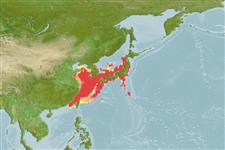分類 / Names
俗名 | 同種異名 | Catalog of Fishes(屬, 種) | ITIS | CoL | WoRMS | Cloffa
Elasmobranchii
板鰓亞綱 (鯊魚與魟魚) (sharks and rays) >
Pristiophoriformes (Saw sharks)
鋸鯊目 (Saw sharks) >
Pristiophoridae (Saw sharks)
鋸鯊科 (Saw sharks)
Etymology: Pristiophorus: pristio-, presumably derived from prio (Gr.), to saw, but treated here as a noun (a saw); phorus, from phoreus (Gr.), bearer or carrier, referring to saw-like snout (note also that pristis is Greek for sawfish) (See ETYFish); japonicus: -icus (L.), belonging to: Japan, where type locality (not specified) is situated (See ETYFish).
More on author: Günther.
Environment: milieu / climate zone / depth range / distribution range
生態學
海洋 居於水底的; 深度上下限 0 - 500 m (Ref. 54710). 深水域; 48°N - 22°N, 118°E - 145°E (Ref. 54710)
Northwest Pacific: Japan, Korea, northern China. Does not occur in the Western Central Pacific (Ref. 31368).
西北太平洋: 日本,韓國,中國北部。 不會出現在中西太平洋.(參考文獻 31368)
大小 / 重量 / 年齡
Maturity: Lm ? range ? - ? cm
Max length : 136.0 cm TL (female)
Pristiophorus japonicus has a long, narrow, and narrowly tapering rostrum (rostrum length is 26-29% of TL), distance from rostral tip to barbels about equal or slightly greater than distance from barbels to mouth (1:1.1-1.2); distance from rostral barbels to nostrils about equal to distance from nostrils to 1st gill slits. About 15-26 large rostral teeth on each side of the rostrum in front of the barbels, 9-17+ behind them; distance from mouth to nostrils 1.1-1.2 times internarial space. Tooth rows 34-58 in upper jaw. Dorsal and pectoral fins covered with denticles in large specimens. Lateral trunk denticles largely unicuspidate. First dorsal fin origin behind free rear tips of pectorals by eye length or more (Ref. 247).
Caudal fin almost straight, with slender upper and lower lobes; pectoral well developed but are not ray-like (Ref. 6871).
日本鋸鯊〔Pristiophorus japonicus〕 有一個長的﹐狹窄的﹐與狹窄尖端細的喙 (喙長度是 26-29% 的 TL) ,從嘴的頂端到觸鬚的距離大約相等或些微大於從觸鬚到嘴 (1:1.1-1.2) 的距離; 從嘴的觸鬚到鼻孔的距離大約等於從鼻孔到第一鰓縫的距離。 大約 15-26 大的嘴在觸鬚之前牙齒在喙的兩邊, 在他們後面的 9-17+; 距離從嘴巴到鼻孔 1.1-1.2 倍於鼻孔間隙。 在上頜中的齒列 34-58。 背部的與胸鰭在大的個體中覆蓋著細齒了。 側面的軀幹細齒相當單尖端。 第一背鰭起點在眼徑或更多的胸鰭的鰭游離後端後面。 (參考文獻 247)
尾鰭幾乎直的, 有細長的上葉與下葉; 胸的發展良好的但是不是像鰭條一樣的.(參考文獻 6871)
Lives on continental shelves and upper slopes on or near the bottom. Also found in coastal waters on sand or mud bottoms. Feeds on small bottom organisms using its barbels to poke the bottom with its snout. Ovoviviparous, with 12 young in a litter.
生活在大陸棚與上層斜坡在底部上面或附近。 也發現於沿岸水域的砂上或泥底。 吃使用它的觸鬚撥開底部的小的底部生物用它的吻。 卵胎生的, 具有 12 幼魚在一胎。
Life cycle and mating behavior
成熟度 | 繁殖 | 產卵場 | 卵 | 孕卵數 | 仔魚
Ovoviviparous, embryos feed solely on yolk (Ref. 50449).西北太平洋: 日本,韓國,中國北部。 不會出現在中西太平洋.(參考文獻 31368)
Compagno, L.J.V., 1984. FAO Species Catalogue. Vol. 4. Sharks of the world. An annotated and illustrated catalogue of shark species known to date. Part 1 - Hexanchiformes to Lamniformes. FAO Fish. Synop. 125(4/1):1-249. Rome, FAO. (Ref. 247)
IUCN 瀕危狀態 (Ref. 130435: Version 2024-1)
無危 (LC) ; Date assessed: 27 August 2019
人類使用
漁業: 商業性
工具
特別的報告
下載 XML
網路資源
Estimates based on models
Preferred temperature (Ref.
123201): 7.7 - 21.8, mean 17.4 °C (based on 199 cells).
Phylogenetic diversity index (Ref.
82804): PD
50 = 0.5156 [Uniqueness, from 0.5 = low to 2.0 = high].
Bayesian length-weight: a=0.00389 (0.00180 - 0.00842), b=3.12 (2.94 - 3.30), in cm total length, based on all LWR estimates for this body shape (Ref.
93245).
營養階層 (Ref.
69278): 3.8 ±0.58 se; based on food items.
回復力 (Ref.
120179): 低的, 最小族群倍增時間4.5 - 14 年 (Fec=12).
Fishing Vulnerability (Ref.
59153): Very high vulnerability (82 of 100).
